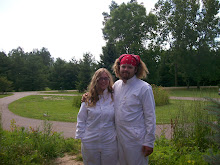So Friday afternoon I received another phone call from Ron, the same guy that had called us about out first swarm in Brighton, he was calling to tell me he found us another swarm! Talk about a lucky charm! He works over near
Kensington Metropark in those rock quarry's off of Muir Road, and inside a weight of a front-end loader, was a rather large swarm of bee's!
This is not your usual situation in which one comes across honey bee's, but when you find them, you either take them up or the swarm will disappear within hours. It's in the bee's nature to take habitat in a temporary place with their queen while other worker bee's go out and orient themselves to the landscape and search for food and shelter. How the bee's came to find shelter in a small cavity about the size of a carton of half and half, is beyond me, but I'm glad we met Ron and got that call!
Keith and I took to the bee's with just a spray bottle of sugar syrup and a small paint brush. Sugar syrup is a dream when you're working with bee's that are feral or swarmed, because they don't have anything to protect, so they're very docile but you don't have anything to calm them about because they don't have anything to protect(i.e. brood stored in cells and capped honey stores) Sugar syrup is 1 part cane sugar to 1 part water and helps the bee's to clump together and not fly around so much in a disturbance, and it also helps to calm the bee's because now they're concerned with cleaning each other off and making the most of this free nectar, rather than discovering why you might be invading their territory. The paint brush was not so much a technical tool as we didn't have any other way to get the bee's out of that
crevice other than using our hand! There is a such thing as a 'bee brush' and it is a technical tool. It's made of very soft, durable fibers that gently brush bee's off of a frame or, say, away from a steel plate, which would enable us to scoop or brush them into the hive body we brought along. We never thought too much about using a bee brush, and we don't currently have one, but after capturing that hive, we have a new found respect for the bee brush. During the spraying and brushing of the bee's from the small cavity, many of the worker bee's sacrificed themselves and stung at the paint brush, alerting us to their dislike. But for lack of better options, we continued to use the brush.
Capturing a swarm is a rush, but it's not as terrifying or complicated as you might imagine it to be. We just show up with a spray bottle and spray them down heavily, then we brush them with the bee brush, or in our case, the paint brush, then we wait for a few to calm down and not fly so directly in to us to scare us off and then repeat the process.
Something to be aware of when capturing the swarm is that it can take hours for all of the bee's to migrate into a hive after you've located the queen, and it's not always possible to spot the queen when dealing with a swarm. A swarm is a time sensitive matter. There is always the chance that you're capturing a swarm without their queen and all of your work will be for nothing; a swarm without a hive, that is then captured without a queen has no chance of survival. So your choices sometimes fall down to either "stay and spot the queen and get her into the hive" or "get enough bee's into the hive body that will then alert the other bee's of a proper shelter space, and hope that they will lure the queen with their 'waggle dance.'" Luckily Keith did brush the queen from the front end loader, but it did take a good while to spot her. I noticed her walking across the bee's with her long abdomen, and she had a spot on her rather than striping like a standard bee. Most of the queen's we have do not have striping, however we are opening ourselves to the fact that a queen will always be most distinguishable by her size and shape rather than her coloring or striping.
The genus we captured this time was the standard Italian bee, which is what almost all of our hives are comprised of. The feral swarm we captured in Brighton however, was the European Dark Bee. The European Dark Bee used to be a Michigan standard bee to keep years ago. But they are prone to swarming, and do not overwinter as well as the Italian, so the Italian has become the standard practice of beekeeping, and the European Dark was left to become a Michigan Feral strain of bee's. The European Dark is also not as strong of a honey and wax producer, therefore, having a apiary full of
European rather than
Italian bee's will yield you less honey per harvest.









